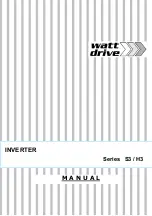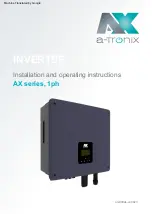
This mode is activated by pressing the
push button. An LED indicator beside the
button confirms this action.
When a Remote Start signal is applied to the
remote start input, the following sequence is
initiated:
The Remote Start Active indicator illuminates (if
configured)
To allow for false signals the Start Delay timer is
initiated.
After this delay the Fuel Solenoid is energized,
then one second later, the Starter Motor is
engaged. The engine is cranked for a pre-set time
period. If the engine fails to fire during this cranking
attempt then the strter motor is disengaged for
the pre-set period. Should this sequence continue
beyond the set number of attempts, the start
sequence will be terminated and Fail to Start
fault will be displayed accompanied by a
flashing shutdown symbol.
When the engine fires, the starter motor disengaged
and locked out at a pre-set frequeny from the
alternator output. Rising oil pressure can also be
used to disconnect the starter motor, however it
cannot be used for under speed or over speed
detection.
If an auxiliary output has been selected to give a
load transfer signal, this would then active.
On removal of the Remote Start signal, the stop
delay timer is initiated, once it has timed out, the
Load Transfer is de-energise, removing the load.
The cooling timer is then initiated, allowing the
engine a cooling down period off load before shutting
down. Once the Cooling timer expires the Fuel
Solenoid is de-energised, bringing the generator to
a stop.
Should the Remote Start signal be re-activated
during the cooling down period, the set will return
on load.
Check the precautions and controls starting up
the generating set.
NOTE: If a digital input configured to panel lock
is active, the LCD will display the icon. When
in panel lock, changing modules will not be possible.
Viewing the instruments and event logs
is not affected by panel lock.
To initiate a start sequence in MANUAL press
the pushbutton. When the controller is in the
manual button), pressing the START (1) button
will initiate the start sequence.
NOTE: There is no Start Delay in this mode of
operation.
The Fuel Solenoid is energized, then the Starter
Motor is engaged. The engine is cranked for a
preset time period. If the engine fails to fire during
this cranking attempt then the starter motor is
disengaged for the preset rest period. Should this
continue beyond the set number of attempts, the
start sequence will be terminated and fail to start
fault will be displayed accompanied by a
flashing shutdown indicator.
When the engine fires, the starter motor disengaged
and locked out at a pre-set frequency from the
Alternator output. Rising oil pressure can also be
used to disconnect the starter motor, however it
cannot be used for under speed or over speed
detection.
The generator will run off load, unless a Remote
Start signal is applied, and if Load Transfer has been
selected as a control source, the appropriate auxiliary
output selected will active.
If the Remote Start signal is removed, the generator
will continue to run On load until Auto mode is
selected. The Remote Stop Delay Timer will time
out, the load is then disconnected. The generator
will then run off load allowing the engine a cooling
down period.
Selecting STOP (0) de-energises the Fuel Solenoid,
bringing the generator to a stop.
24
7.4 Starting with P2010 Autostart
Control Panel
7.4.1 Manual Operation
7.4.2 Automatic Mode of Operation
NOTE: If a digital input configured to panel lock
is active, the LCD will display the icon.
When in panel lock, changing modules will not
be possible.
Viewing the instrument and event logs
is not affected by panel lock.
AUTO
Figure 7. 4
Desription of Controls on DSE5210 module
User configurable
LCD indicators
with text insert
LCD display
Config /
log button
Scroll
button
Load
indicators
Alarm
indicators
Stop mode
Manual mode
(config.)
Start button
(when in manual)
Generator
indicators
Auto mode
(config enter)
















































